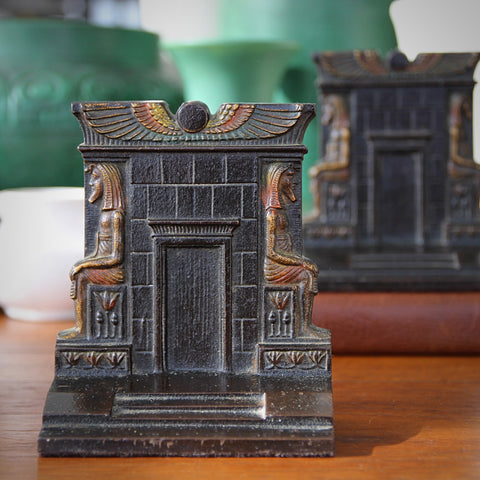After my Summer's Trip of a Lifetime—to Egypt and Jordan—I am more committed than ever to collecting Egyptian Revival decor: bookends, paintings, desk accessories. I love items, even Western items, which express the world's riveting fascination with Egypt's ancient treasures, some of them being rediscovered after centuries of being buried under sand. The bookends shown here, made by Bradley & Hubbard in the Twenties, remind me of the Temple of Rameses II in Abu Simbel, Egypt (in "Upper Egypt," that is, in the South of the country, close to the border with Sudan). While the artist-sculptor took great liberties with the arrangement of elements, here we see the temple entrance, flanked by seated likenesses of the pharaoh, Rameses II. The "Winged Sun of Horus" hovers protectively over the pharaoh—guarding him and conferring divine authority upon the pharaoh, God on Earth.
The Twenties were a fertile time for Egyptian Revivalism. After King Tutankhamun's tomb was rediscovered by Howard Carter (and company) in 1922, the world renewed its fascination with Egyptology (and not for the first time). Even though Tutankhamun was a young (and less wealthy) king, his relatively-intact tomb was filled with beautiful objects which mesmerized the world. The Twenties was also the beginning of the wildly-popular (and long-lived) Art Deco movement. Egyptian decorative motifs were widely adapted for use in Western Art Deco art, architecture, product design and graphics. Bookends were no exception.

My husband, Bob Perdziola, contemplates the magnificence of Rameses II.
This Summer, we visited the Temple of Rameses II, found in Abu Simbel, Upper Egypt (which is in the South, that is, up the Nile). The temple, built between 1264 BC and 1244 BC, was the pharaoh's way of showing the Nubians (who had lots of gold!) who was boss. His presence in their region—at least through his magnificent temple—was Rameses II's way of overwhelming the locals with his power, might and divine authority. He also built another, smaller temple nearby to honor his chief wife, Nefertari. The temples (and the civilization which surrounded them) would serve to "Egyptianize" the territory, to bring it under the influence and control of the distant king.
Over the centuries, the temple was (somehow) forgotten, having been mostly covered-up with the shifting desert sands. In 1813, Swiss archaeologist Johann Ludwig Burckhardt re-discovered the mostly-hidden temples. The Early Nineteenth Century was a time of great European interest in Egyptian antiquities, most prominently by Napoleon, which resulted in Egyptian Mania in French decorative arts—called the Empire Movement ("Ahm-peer").
When the new Aswan Dam was built in the 1960's, it was designed to flood much of the Nubian territory. The resulting Lake Nasser also threatened to submerge many significant Egyptian archaeological treasures. The distraught Nubian people relocated either further into Egypt or Southward into Sudan. The temples of Rameses II and Queen Nefertari were both moved—stone-by-stone—to higher ground. Today both temples sit, high-and-dry, alongside the tranquil Lake Nasser, now a reservoir of the River Nile and one of the world's largest man-made bodies of water. (The Nubian-Sudanese insist on calling it "Lake Nubia," such is their disgust with Egyptian President Nasser and the flooding his dam caused.)
The bookends, made above, are a stylized rendering of the Temple of Rameses II. They still bear most of their original, polychrome hand-painting. And they capture the allure which Ancient Egypt held for Early Twentieth Century people throughout the West. Click on the photo above to learn more about them.
Though our Greenwich Village store is now permanently closed, LEO Design is still alive and well! Please visit our on-line store where we continue to sell Handsome Gifts (www.LEOdesignNYC.com).
We also can be found in Canonsburg, Pennsylvania at The Antique Center of Strabane (www.antiquecenterofstrabane.com).
Or call to arrange to visit our Pittsburgh showroom (by private appointment only). 917-446-4248


